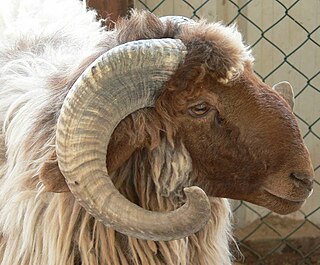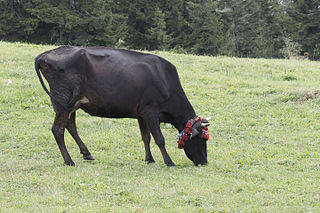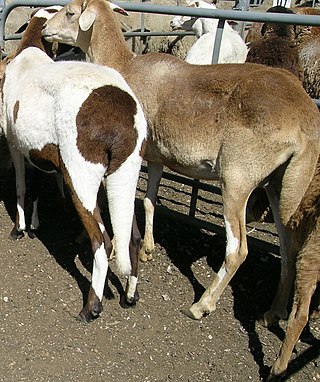 Cape Sheep | |
| Other names | Cape Fat-tailed |
|---|---|
| Country of origin | South Africa |
| Hair colour | white |
| Face colour | red, black |
| Notes | |
| adept to desert conditions | |
| |
The Afrikaner sheep or Cape Fat-tailed is a breed of fat tailed, hair sheep indigenous to South Africa.
 Cape Sheep | |
| Other names | Cape Fat-tailed |
|---|---|
| Country of origin | South Africa |
| Hair colour | white |
| Face colour | red, black |
| Notes | |
| adept to desert conditions | |
| |
The Afrikaner sheep or Cape Fat-tailed is a breed of fat tailed, hair sheep indigenous to South Africa.
Afrikaner sheep are one of the oldest native sheep breeds in South Africa, along with sheep such as the Damara, Blackhead Persian, Pedi, and Zulu (Nguni). [1] Their ancestors were brought down from the middle east by the Khoikhoin people. [2] Ronderib Afrikaners are thought to be the first sheep imported to Australia, with the First Fleet in 1788, but today are very rare in the country. [3]
There are two varieties of Afrikaner sheep; the Namaqua Afrikaner and the Ronderib Afrikaner. The long, fat tail is an energy store which helps them survive long dry seasons.
The Namaqua Afrikaner is known for its hardiness in extreme environmental conditions. [4] It is a slender, lanky sheep with a fat tail, and is not particularly favoured for modern lamb production. Namaqua Afrikaners are generally white with a red or black head, and large fat tails. What the breed lacks in market meat desirability, it makes up for in its foraging ability and hardiness in desert conditions. [5]
The Ronderib Afrikaner is one of the larger breeds of South African indigenous sheep. There are two known sub varieties of this breed, one that has soft, fine, shiny hair being the Blinkhaar Ronderib Afrikaner, and the Steekhaar Ronderib Afrikaner having coarse hair, which was thought to be extinct. However, twenty animals were found in 1995 on a farm near Upington. The ribs of both are oval in cross section rather than flat. It is these two characteristics of coat and rib shape which distinguish this distinctive breed. Like the Namaqua Afrikaner (mentioned above) the breed is very adept to desert conditions and is remarkable for the long seasons it can survive with little or no water. The Ronderib Afrikaners show further characteristics of desert animals in that, similar to the gemsbok, their heels are close together. The aim of the old Ronderib breeders was to develop sheep with shiny coats suitable for making of skin blankets. [6]
The Damara is a Namibian breed of fat-tailed hair sheep, also found in South Africa. The name derives from that of the Damara region of northern Namibia where it is principally found, particularly in the Kaokoveld Desert. Together with the Namaqua Afrikaner and the Ronderib Afrikaner, it is one of three breeds in the Afrikaner group of sheep that were already in southern Africa before the arrival of colonists, and which forms part of the broader African Long-fat-tailed sheep grouping. It may be solid black, brown or white, or black-and-white pied.

Karakul or Qaraqul is a breed of domestic fat-tailed sheep which originated in Central Asia. Some archaeological evidence points to Karakul sheep being raised there continuously since 1400 BC.

The Highland Pony is a native Scottish pony, and is one of the largest of the mountain and moorland pony breeds of the British Isles. Its pedigree dates back to the 1880s. It was once a workhorse in the Scottish mainland and islands, but today is used for driving, trekking and general riding. They are hardy and tough, they rarely require shoeing, and are economical to keep.

The Gloucestershire Old Spots is an English breed of pig which is predominantly white with black spots. It is named after the county of Gloucestershire. The Gloucestershire Old Spots pig is known for its docility, intelligence, prolificity, and hardiness. Boars reach a mature weight of 600 lb (272 kg) and sows 500 lb (227 kg). The pigs are white with clearly defined black spots. There must be at least one spot on the body to be accepted in the registry. The breed's maternal skills enable it to raise large litters of piglets on pasture. Its disposition and self‑sufficiency should make it attractive for farmers raising pasture pigs and those who want to add pigs to diversified operations.

The Jacob is a British breed of domestic sheep. It combines two characteristics unusual in sheep: it is piebald—dark-coloured with areas of white wool—and it is often polycerate or multi-horned. It most commonly has four horns. The origin of the breed is not known; broken-coloured polycerate sheep were present in England by the middle of the seventeenth century, and were widespread a century later. A breed society was formed in 1969, and a flock book was published from 1972.

The fat-tailed sheep is a general type of domestic sheep known for their distinctive large tails and hindquarters. Fat-tailed sheep breeds comprise approximately 25% of the world's sheep population, and are commonly found in northern parts of Africa, the Middle East, and various Central Asian countries, Afghanistan, Pakistan and all the way to China. The tail fat from those sheep is an important ingredient in many regional cuisines.

The Awassi is a breed of dairy sheep of Near-Eastern fat-tailed type. It is the most widely distributed non-European dairy breed. It is known by many names, among them Arab, Baladi, Deiri, Gezirieh, Ivesi, Shami and Syrian. It is usually white with brown head and legs.

The Dorper is a South African breed of domestic sheep developed by crossing Dorset Horn and the Blackhead Persian sheep. The breed was created through the efforts of the South African Department of Agriculture to breed a meat sheep suitable to the more arid regions of the country. It is now farmed in other areas as well, and is the second most common sheep breed in South Africa.

The Katahdin is a modern American breed of sheep. It is an easy-care sheep: it grows a hair coat with little wool which moults naturally in the spring, and so does not need to be shorn. It is reared for meat only.

The Shetland is a small, wool-producing breed of sheep originating in the Shetland Isles, Scotland, but is now also kept in many other parts of the world. It is part of the Northern European short-tailed sheep group, and it is closely related to the extinct Scottish Dunface. Shetlands are classified as a landrace or "unimproved" breed. This breed is kept for its very fine wool, for meat, and for conservation grazing.

The Anatolian Black, also known as Native Black Cattle, is a breed of cattle that originated in Anatolia, in what is now Turkey. They are used in dairy production, meat production, and as draught animals on small farms. They are primarily raised in central Turkey.

The St Croix is a breed of domestic sheep native to the U.S. Virgin Islands and named for the island of Saint Croix. They are often also called Virgin Island White because those that were imported into North America were selected for white coloration. On the Island of St. Croix, they come in shades of brown, white, and black.

The Blackhead somali sheep is a fat-tailed breed of domestic sheep from Africa. The sheep is originally from Somalia and a direct descendant of the Somali sheep. The breed is also a type of hair sheep, meaning they do not grow wool and tolerate heat better than wooled breeds and are raised primarily for meat. The Blackhead Persian has a white body and, as their name would suggest, an entirely black head.

The Boreray, also known as the Boreray Blackface or Hebridean Blackface, is a breed of sheep originating on the St Kilda archipelago off the west coast of Scotland and surviving as a feral animal on one of the islands, Boreray. The breed was once reared for meat and wool, but is now used mainly for conservation grazing. The Boreray is one of the Northern European short-tailed sheep group of breeds.

The Meatmaster is a modern South African breed of domestic sheep. It was bred in the early 1990s from various hair sheep breeds, with the goal of improving the meat characteristics of African fat-tailed sheep breeds. The fat-tailed sheep had various advantageous characteristics such as hardiness and suitability for desert life, but was slow to mature, had a poor distribution of fat and lacked the muscling of the hind quarters of European breeds. The composite breed increased the amount of muscle and had a better distribution of fat but retained the hair coat and other desirable traits such as resistance to tick-borne diseases and a good flocking instinct.
The Van Rooy, also known as the Van Rooy White Persian, is a breed of domestic sheep native to South Africa. The Van Rooy was first developed in 1906 by J. C. van Rooy, a South African Senator and farmer in the Bethulie district. The Van Rooy is cross between indigenous Ronderib Afrikaner sheep, and Rambouillets. It is a fat-tailed sheep and also a hair sheep, removing the need for shearing and crutching. They are generally kept for meat production, and are very well-suited to arid climates. Van Rooys are polled, have drooping ears, and are entirely white. The breed is relatively rare, even in South Africa, but has also been exported to Namibia and Zimbabwe.

The Red Maasai is a breed of sheep indigenous to East Africa. True to its name, the breed is kept by the Maasai, though both pastoralists and smallholder farmers in Kenya, Tanzania, and Uganda keep Red Maasai flocks.
The Zulu sheep breed is native to South Africa and is predominantly raised by rural farmers in the province of KwaZulu-Natal. It serves primarily as a source of food and income to poor resource farmers. It belongs to the Nguni type of sheep together with the Pedi and the Swazi sheep.
The Afrino is a breed of sheep originating from South Africa. It was developed by crossing Ronderib Afrikaner sheep with Merino and South African Mutton Merino (SAMM) sheep, and is classified as a Merino breed.